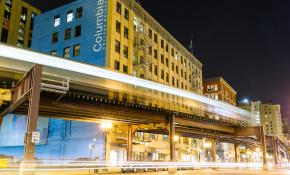I spent last week in Belgrade, Serbia, at a journalism conference. It was surprising (the city is beautiful and somehow both old and new,) incredible (we cruised on the Danube one night at sunset) and humbling (I met journalists from around the world doing powerful work in tough places.)
But I almost didn't get on the plane.
On Tuesday, as Hurricane Irma churned out at sea, I wasn't sure if or when I'd make it back to Florida and my family. On Wednesday, my kids headed to St. Louis with my Mom. On Friday, my husband joined them. On Sunday, I made it back to St. Louis, too. That night, we sat up listening to our neighbors on Zello and watching updates on Facebook with CNN humming in the background.
We did not have to board up and wait it out. But local journalists did. When their families and friends left, they stayed.
Related Training: World Vision-Poynter Certificate for Emergency Communications
We saw the news they created online, on air and across social media, but we didn't really see what it was like for them. So today, we're taking a look inside Florida newsrooms as they covered this anxiety-inducing, ominous, terrible hurricane. I spoke to everyone here via email or Twitter.
Tampa Bay Times
The Times, which Poynter owns, had to relocate from their window-filled building in St. Petersburg to its printing plant with enough junk food to fuel several newsrooms.
That plant is a maze of corridors, said Ron Brackett, deputy managing editor of Tampabay.com/Presentation, and a lot of people got lost. When the lights flickered, everyone held their breath.
"As the hurricane's eye was parallel with Tampa Bay, a dozen or so of us went outside onto a covered deck to watch the storm," he said. "As (photographer) Dirk Shadd was taking a photo of the group, all the lights in the neighborhood blinked out."

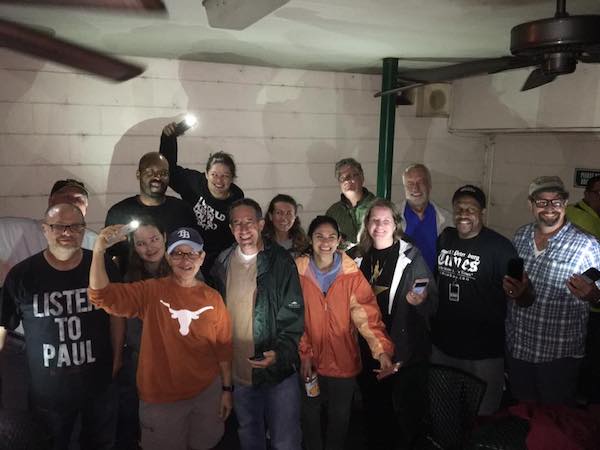
WFTV, Orlando
Everyone pitched in at WFTV. The journalists there worked 12 hours on and 12 hours off. Other Cox Media Group newsrooms pitched in overnight to keep an eye on their social channels. And non-news staff answered phones and kept an eye on Twitter, Instagram and Facebook for reader questions.
The newsroom set up a place to sleep, with curtains offering more than a dozen private spots in a quiet part of the building. They also have men's and women's showers, and the station pre-ordered food and provided meal and snack packs for crews as they headed out into the storm.
"Just like we tell our viewers to get prepared for the storm, we also have to prepare the newsroom team for operations, too," said Katy Camp, digital content manager.
Some people also caught a little sleep in the sales office, but Camp made a comfy spot under her desk.
I pulled a #Costanza & slept under my desk for #Irma #partylikeajournalist pic.twitter.com/ZSCBcegfhS
— Katy Camp (@CCKaty82) September 11, 2017
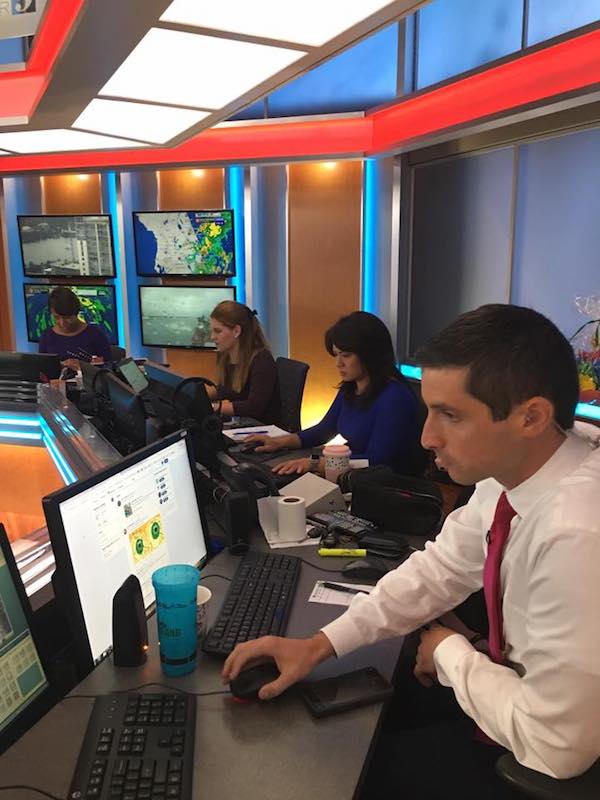

Orlando Sentinel
Like in many newsrooms, some staff stayed in to cover the storm while others embedded around the community. The Orlando Sentinel's Christal Hayes, a breaking news reporter, worked from the Emergency Operations Center, where space was tight and reporters took turns using power outlets and getting a little sleep.
Hayes found a spot to sleep and curled up with her blanket, but mostly worked through the night as the storm hit. She worked alongside veteran photojournalist Red Huber.
"He's a hurricane pro and has been through them all. It was my first time really reporting on one of these," she said. "My notebooks were soaked but thank God for pencils!"

.@RedHuber enjoying his peanut-butter sandwich! He remembered a plastic knife so we don't have to scoop with our fingers! #HurricanePro pic.twitter.com/dWpdJ6a3Rp
— Christal Hayes (@Journo_Christal) September 10, 2017
"Are we leaking?"
"Yup"
"Bring out the avocado!" @OHnewsroom pic.twitter.com/ejye4EnVZC— Michael Williams (@michaeldamianw) September 11, 2017
WFOX, Jacksonville
A couch from an old set was Rachael Hawk's bed for the storm. Staff at WFOX covered Hurricane Matthew last year, so they felt prepared.
But, like many other journalists in newsrooms covering the storm, they had families in Jacksonville and around the state. That, plus the long hours, made the experience a pretty intense one, said Hawk, a digital marketing specialist.
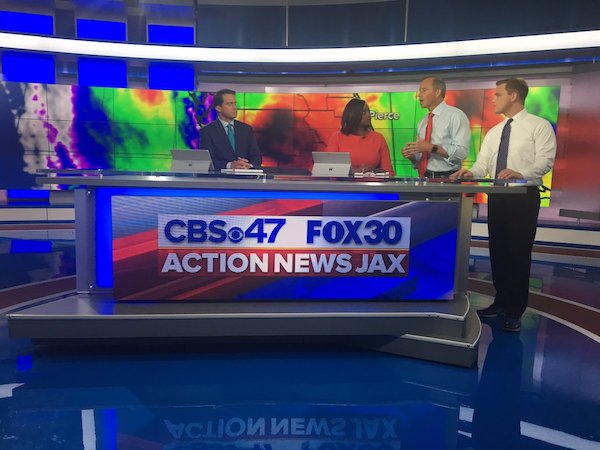
Miami Herald
The Herald offered shelter for staff and family in the newsroom that was once the headquarters of U.S. Southern Command. Jeff Kleinman, day editor, shared images and videos on Facebook of what the storm looked like from behind military-grade windows.
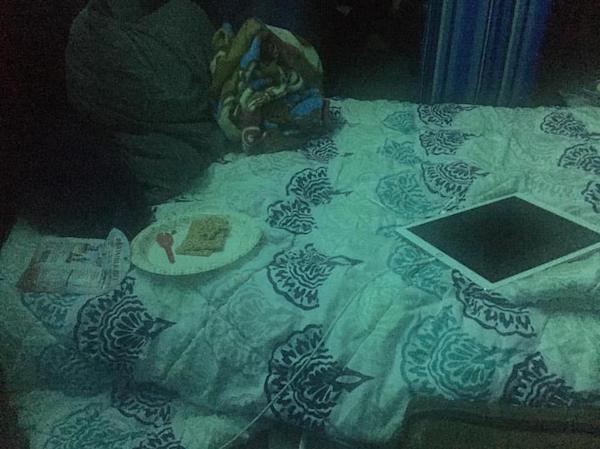

Palm Beach Post
Staff at the Palm Beach Post got a nice surprise before some bad news on Friday. The surprise: a pizza lunch from Axios Media. The bad news: the building, normally used as a shelter from storms for staff and their families, wasn't a safe spot for Irma.
So breaking news reporter Olivia Hitchcock, her boyfriend and her dog headed to a co-worker's. Working with flickering power and internet was pretty maddening, she said. She spent most of Sunday pleading with both while trying to cover the storm.
"It is such a first world problem, but nothing is quite as frustrating as trying to do your job but having power/internet/battery go in and out," she said. "Communication — which is supposed to be our bread and butter — was nearly impossible at times."
Some staff got back in the newsroom on Monday to work.
"But then, the generator went out. Our luck," said Samantha Ragland, manager of digital entertainment strategy. "So we gathered some extension cords (to run from the part of the building that DID have power) and MiFi cards, went to the cafeteria and worked to keep readers updated online while our print staff worked to get the newspaper out for Tuesday."
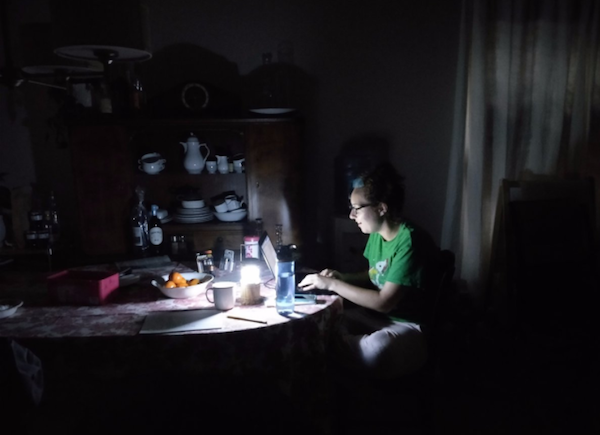
WUSF, Tampa
Staff at Tampa and St. Pete's public radio station worked around the clock from 10 a.m. Sunday morning until 10 a.m. Monday morning. Between 15 and 20 were there covering the storm, including the station's jazz and classical hosts, said news director Mary Shedden.
Reporters also worked from home and in the community, including reporter Daylina Miller, who worked from the old New Port Richey Jail.
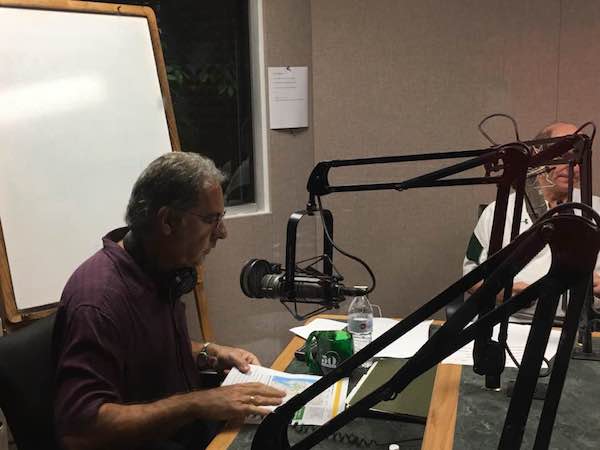
I'll be ok at the old jail as long as the ghost of this guy doesn't come back to haunt me. Possible he's talking about New Port Richey ? pic.twitter.com/1Wo0KXosuS
— Daylina Miller (@DaylinaMiller) September 11, 2017
I feel like I should have my machete ready. Where's Rick Grimes and Daryl Dixon when you need them? #Hurricaneirma @wusf pic.twitter.com/V188zaiWHr
— Daylina Miller (@DaylinaMiller) September 11, 2017
South Florida Sun-Sentinel
The newsroom was open to employees covering the storm, plus their families and pets during the weekend. About 18 staffers worked at the newsroom in Deerfield Beach. Offices became mini-suites with blankets over glass walls. Some slept under desks, on couches, in tents, on air mattresses and even in the locker room, said assistant managing editor David Schutz.
"There were plenty of light moments," he said. "During one of them, at the height of the storm Sunday night, we let our readers join in a live-streamed game of Pictionary."
Journalists were also embedded throughout the community and emerged after the storm passed to show what was left. Reporter Brittany Wallman and photographer Joe Cararetta got stuck in sand from storm surge that washed up on Fort Lauderdale Beach.
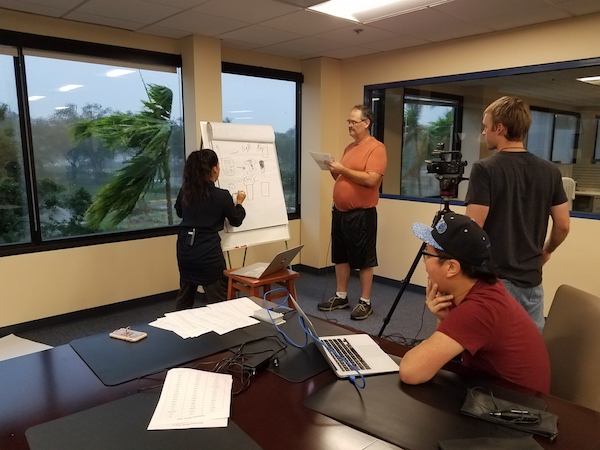
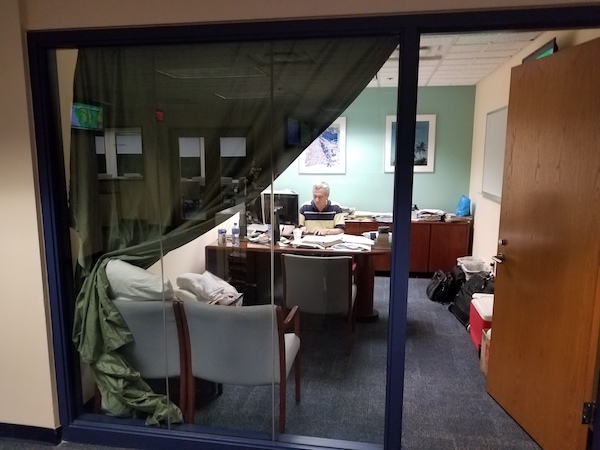

Thanks to everyone who took the time to share images and stories from covering Irma. Next week, we're going to start our next topic: What do journalists need to know about money.
I'm skipping the links this week in favor of some extra sleep. Poynter looks like it held up in the storm, by the way. My colleagues and I are grateful to everyone who checked in on us.
See you next week.


